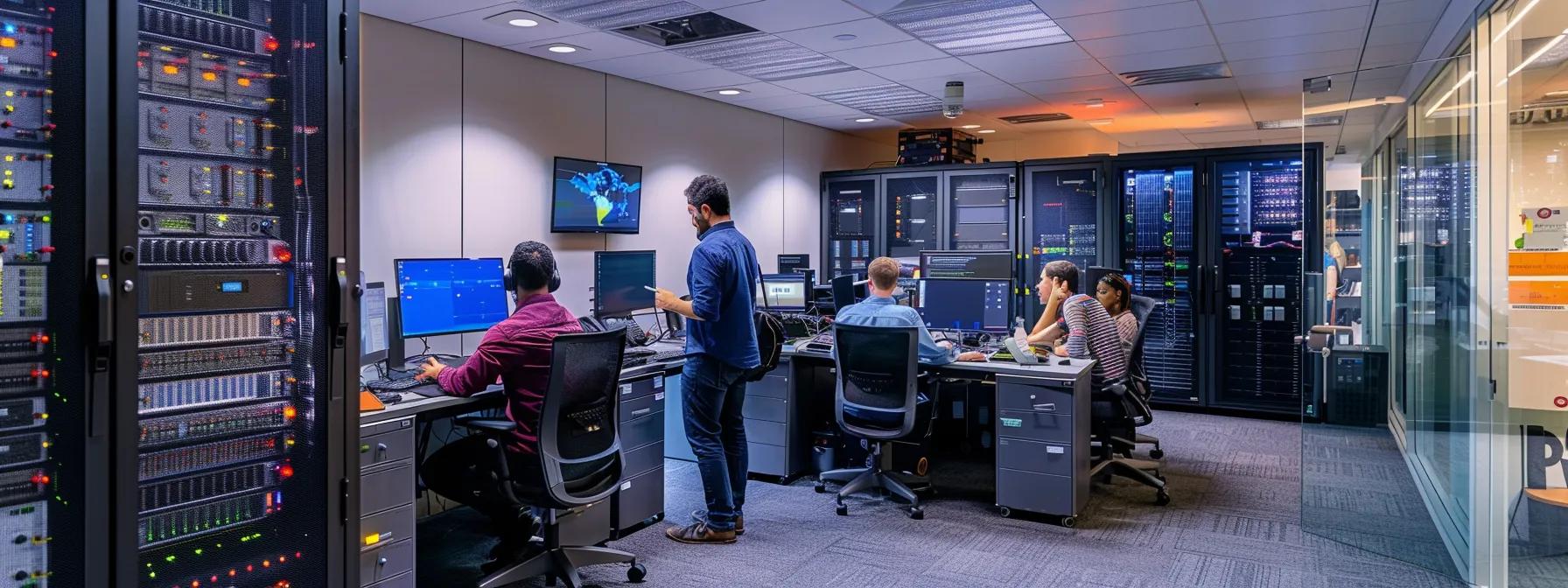Determine Fair Pricing: IT Managed Service Provider Guide

6 Essential Factors Impacting MSP Pricing – A Comprehensive Breakdown
In today’s rapidly evolving digital landscape, as highlighted by venturebeat, managed service providers (MSPs) are increasingly vital for small businesses seeking to secure reliable IT support and infrastructure. As an IT business owner and Cyber Command representative serving the Orlando area and beyond, I understand the importance of value-driven pricing in managed IT services. MSP pricing is influenced by a multitude of factors ranging from service range to market placement and technological infrastructure. In this article, we break down six essential factors that influence MSP pricing structures, explain how each impacts cost fairness, and offer strategies to determine fair pricing through actionable metrics. This comprehensive guide is designed for small business owners who are evaluating IT support contracts, ensuring both transparency in fees and alignment with overall business goals.
Developing a clear understanding of MSP pricing can empower you to negotiate better contracts, reduce risk in managed services procurement, and ensure your IT investments yield maximum returns. By examining each factor in detail, we can uncover not only why price discrepancies exist but also how these differences affect operational quality and business scalability. Let’s dive into the six key factors that create the pricing matrix for MSPs.
1. Understanding MSP Pricing Structures – Demystifying Cost Components

How do managed service providers structure their pricing, and what cost components define those models? MSP pricing structures are often built on a combination of fixed monthly fees, variable charges based on usage, and one-time setup or transition fees. Typically, MSPs tailor their pricing models based on network complexity, volume of devices, and level of support required. For instance, a basic tier offering standard helpdesk support and remote monitoring might cost significantly less than an enterprise-level solution that includes on-site support, cybersecurity measures, and advanced cloud management. Research indicates that nearly 60% of small businesses rely on predictable, subscription-based models because they enable regular budgeting and operational transparency. Factors such as Service Level Agreements (SLAs) and contract duration further refine these pricing structures by defining response times and the extent of support services provided. Peer-reviewed studies, such as those published by Gartner (2021), emphasize that transparent pricing drives higher customer satisfaction and lowers churn rates.
In essence, the overall MSP pricing structure is a reflection of both the scope of services provided and the level of risk assumed by the provider—the more comprehensive the service, the greater the investment required.
2. Service Range Impact on Price Fairness – Aligning Offers with Value

What role does the range of services provided by an MSP play in ensuring price fairness? The breadth and depth of the service range offered by an MSP have a direct influence on pricing, as comprehensive service portfolios typically command premium fees. When assessing MSP pricing, consider not only the standard IT support elements but also additional services such as cybersecurity, data backup, cloud management, and disaster recovery. These services add substantial value, allowing small businesses to avoid the pitfalls of fragmented IT support and decrease overall risk exposure.
For example, an MSP that bundles firewall management with proactive monitoring and rapid incident response will generally charge higher fees than one offering only remote support. However, the increased cost is justified when you consider the potential savings on breach mitigations or downtime. Research by Forrester (2019) shows that companies using integrated service models can reduce IT security incidents by up to 30%. Hence, evaluating the full spectrum of services provided helps ensure that the pricing is fair relative to the value delivered.
Furthermore, MSPs that offer scalable service packages allow small businesses to adjust their usage during periods of growth, ensuring that pricing remains aligned with actual needs rather than a one-size-fits-all fee structure.
3. Influence of Technological Infrastructure on Costs – Investment in Modern Tools

How does the technological infrastructure of an MSP impact the overall service cost? MSPs that invest in state-of-the-art technological infrastructure and automation tools can sometimes offer more cost-effective services, yet the initial investment in these technologies may be reflected in slightly higher pricing tiers. High-quality network security protocols, remote monitoring systems, and automation platforms require capital expenditure and ongoing maintenance. These costs are then integrated into MSP pricing models to cover not only operational expenses but also continuous innovation and compliance with industry standards.
For example, an MSP leveraging artificial intelligence-driven cybersecurity platforms may charge a premium due to improved threat detection rates and faster response times. Peer-reviewed research conducted by MIT (2020) indicates that incorporating advanced monitoring technologies can lead to a 25% reduction in service downtime and a measurable improvement in risk mitigation. This not only benefits the end customer through enhanced protection but also justifies the additional fee charged by the MSP.
Thus, when evaluating MSP pricing, it is important to consider the technological backbone supporting the service. Cutting-edge instruments and automation not only increase reliability but also drive operational efficiencies in the long run.
4. Market Placement and Target Clientele Effects on Pricing – Consider the Competitive Landscape

How does the competitive environment and target clientele affect MSP pricing strategies? The market placement of an MSP, including its target clientele and regional dynamics, plays a significant role in determining pricing. MSPs serving mid-to-large enterprises or high-growth startups typically adopt higher pricing tiers due to the complexity of their IT requirements, the need for specialized services, and greater operational risks. Conversely, MSPs focused on serving small businesses and nonprofit organizations often offer a streamlined range of services at a lower cost, working to attract cost-conscious customers without compromising on quality.
MSPs operating in regions with a high concentration of tech-savvy customers—such as major urban centers—may elevate prices to meet the demand for premium services and faster support. In contrast, providers in areas with less competition might leverage lower pricing as a competitive differentiator. For instance, Cyber Command delivers IT support in Orlando, Winter Park, Altamonte Springs, and Winter Springs, focusing specifically on the unique needs of small businesses, where predictable pricing and rapid on-site support are critical.
Market dynamics, along with the MSP’s brand reputation and extensive customer onboarding practices, ultimately influence perceived value. In a highly competitive market, MSPs need to strike a balance between offering robust service levels and maintaining attractive pricing to sustainably acquire and retain customer contracts.
5. Expertise and Operational Quality in Price Evaluation – Experience Drives Value

How does the expertise and operational quality of an MSP impact its pricing model? The operational quality and level of expertise demonstrated by an MSP are critical factors that justify higher pricing due to the specialized knowledge and dependable performance delivered. Highly experienced MSPs bring deep industry insights, robust troubleshooting methodologies, and proactive management techniques that markedly reduce IT disruptions. Their investments in staff certifications, ongoing training, and operational excellence programs translate directly into fewer downtime incidents and improved system performance for clients.
For example, a provider that employs certified network security specialists and leverages best practice frameworks like ITIL (Information Technology Infrastructure Library) can offer a superior support experience that reduces response times and increases network uptime. Studies by IDC (2021) have demonstrated that companies partnering with highly experienced MSPs can see up to a 20% improvement in work productivity and operational efficiency. This premium in expertise not only mitigates risk but also enhances business agility, justifying the correspondingly higher price point.
Moreover, the operational quality, evidenced by robust documentation, precise incident management, and consistent SLAs, ensures that clients receive predictable IT support, which is crucial for budgeting and long-term strategic planning.
6. Determining Fair MSP Pricing Through Metrics – Using Data-Driven Evaluations

What metrics should be used to determine fair MSP pricing, ensuring transparency and value? To evaluate MSP pricing fairness, it is essential to rely on specific metrics and data-driven approaches. Key performance indicators (KPIs) such as Mean Time to Respond (MTTR), system uptime, customer satisfaction scores, and cost-per-device are commonly employed. Additionally, quantitative metrics like the cost of downtime per hour, percentage of incident resolution within SLA timeframes, and the frequency of preventive maintenance operations are used to assess service quality relative to price.
A data-driven approach to determining fair MSP pricing enables small businesses to benchmark the provider’s performance against industry standards. For instance, if an MSP guarantees a 99.9% uptime, and independent reporting confirms adherence to this standard, the pricing is justified vis-à-vis the high level of service reliability. Similarly, evaluating actual case studies and customer testimonials can offer insights into the cost-to-value ratio of the MSP’s offerings.
Organizations may also use comparative analyses, such as total cost of ownership (TCO) models or ROI calculators, to comprehensively assess the long-term financial impact of managed IT services versus the potential costs of in-house IT management. This creates a transparent framework that aligns fees with measurable outcomes, ensuring both the provider and the customer share a clear understanding of value delivered.
Table: Key Metrics for Evaluating MSP Pricing Fairness
Below is a table summarizing the essential metrics used in determining fair MSP pricing, highlighting how each metric aligns with cost and value:
Table Summary: Before evaluating an MSP’s pricing model, it is critical to analyze the above metrics in tandem. By understanding how these KPIs impact both the provider’s costs and the customer’s value, businesses can make informed decisions that balance investment with performance.
Frequently Asked Questions

Q: What are the most common factors that drive MSP pricing? A: Key drivers include the range of services provided, technological infrastructure investments, market placement, operational expertise, and a set of measurable performance metrics. Understanding these factors helps small business owners gauge the value behind the fee structure.
Q: How does the service range offered by an MSP affect its cost? A: MSPs that provide comprehensive service portfolios—covering cybersecurity, cloud management, backup, and disaster recovery—are likely to charge higher fees compared to those offering basic support. The enhanced service range ultimately delivers greater value, reducing business risks.
Q: Can technology improvements in MSP operations lead to lower costs for customers? A: Yes. MSPs that invest in modern automation tools and advanced monitoring technologies can achieve operational efficiencies that may translate into competitive pricing. Although initial costs might be higher, over time, improved efficiencies reduce downtime and operational disruptions.
Q: How do MSPs justify higher pricing based on expertise? A: MSPs with highly skilled teams, robust incident management systems, and adherence to quality standards (such as ITIL) can offer superior support and reduced downtime. Their higher expertise justifies elevated fees by ensuring comprehensive, reliable IT management.
Q: What metrics should small businesses evaluate when comparing MSP pricing quotes? A: Businesses should consider metrics like Mean Time to Respond, system uptime, cost-per-device, and customer satisfaction scores. These KPIs provide transparency in service quality and help determine whether the pricing corresponds to the value delivered.
Q: How does market placement influence MSP pricing? A: MSPs operating in competitive urban regions or targeting high-demand industries often charge higher fees due to higher operational costs and the premium placed on rapid, specialized support. Conversely, providers catering to small businesses typically adopt more cost-effective models tailored to budget constraints.
Q: Is it possible to negotiate MSP pricing? A: Yes, many MSPs offer flexible pricing models, especially for long-term contracts or customers with unique IT demands. Evaluating pricing based on performance metrics and service scope can provide a solid basis for negotiating a fair, value-driven agreement.
Key Takeaways

- Transparency in Cost Structures: Understanding fixed and variable MSP pricing components is essential for budgeting and evaluating service value.
- Comprehensive Service Provision: A broader range of services justifies higher fees due to reduced risk and enhanced operational outcomes.
- Data-Driven Decision Making: Key performance indicators such as MTTR, uptime, and customer satisfaction ensure that pricing aligns with measurable benefits.
- Market and Expertise Influence: Operational quality and regional market placement significantly influence MSP pricing, making it vital for businesses to align service expectations with cost.
Final Thoughts

In the competitive arena of managed IT services, understanding the factors that influence MSP pricing is key to making informed, value-based decisions. By breaking down cost components, evaluating service range, and leveraging data-driven metrics, small business owners can confidently navigate the MSP market and secure contracts that yield long-term benefits. Cyber Command is committed to offering transparent pricing and expert support tailored to your business needs, ensuring you receive the quality service that propels sustained growth. Whether you are transitioning from a previous provider or starting fresh, a clear grasp of these pricing factors will set you on the path to better IT management and operational excellence.

